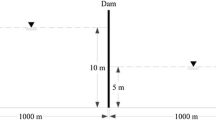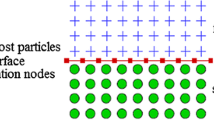Abstract
In this paper, the unsteady two-dimensional dam-break flow of Newtonian and thixotropic fluids is numerically investigated by smoothed particle hydrodynamics. In this method, the flow domain is replaced by several representative particles, and the mass and momentum conservation equations are solved in a Lagrangian framework for each representative particle. First, the Newtonian and shear-thinning cases are verified with previous numerical and experimental published results. Then, the dam-break flow of a thixotropic liquid obeying Moore’s rheological model is simulated. Several simulations are performed to investigate the effects of the model parameters. Furthermore, the differences between Newtonian and thixotropic fluid flow (including free surface shape and leading edge) are investigated. It is shown that the thixotropic behavior of fluids could dramatically affect the free surface shape and spreading speed.









Similar content being viewed by others
References
Cochard C, Ancey C (2009) Experimental investigation of the spreading of viscoplastic fluids on inclined planes. J Non-Newton Fluid Mech 158:73
Moore F (1959) The rheology of ceramic slips and bodies. Trans Br Ceram Soc 58:470
Tehrani A (2008) Thixotropy in water-based drilling fluids. Ann Trans Nordic Rheol Soc 16:1
De Souza Mendez PR (2009) Modeling the thixotropic behavior of structured fluids. J Non-Newton Fluid Mech 164:66
Ahmadpour A, Amini-Kafiabad H, Sadeghy K (2013) Dynamics of gas bubbles surrounded by Dullaert-Mewis thixotropic fluid. Nihon Reoroji Gakk (J Soc Rheol Jpn) 41:309
Martin JC, Moyce WJ (1952) An experimental study of the collapse of liquid columns on a rigid horizental plane. Philos Trans R Soc Lond 244:312
Piau JM, Debiane K (2005) Consistometers rheometry of power-law viscous fluids. J Non-Newton Fluid Mech 127:213
Liu Y, Balmforth NJ, Hormozi S (2018) Axisymmetric viscoplastic dambreaks and the slump test. J Non-Newton Fluid Mech 258:45
Shadloo MS, Oger G, Le Touze D (2016) Smoothed particle hydrodynamics method for fluid flows, towards industrial applications: Motivations, current state, and challenges. Comput Fluids 136:11
Lio GR, Lio MB (2003) Smoothed particle hydrodynamics: a meshfree particle method. World Scientific publishing, Singapore
Shao S, Lo EYM (2003) Incompressible SPH method for simulating Newtonian and non-Newtonian flows with a free surface. Adv Water Res 26:787
Roubtsova V, Kahawita R (2006) The SPH technique applied to free surface flows. Comput Fluids 35:1359
Dalrymple RA, Rogers BD (2006) Numerical modeling of water waves with the SPH method. Coastal Eng 53:141
Hosseini SM, Manzari MT, Hannani SK (2007) A fully explicit three‐step SPH algorithm for simulation of non‐Newtonian fluid flow. Int J Numer Methods Heat Fluid Flow 17:715
Molteni D, Colagrossi A (2009) A simple procedure to improve the pressure evaluation in hydrodynamic context using the SPH. Comput Phys Commun 180:861
Xu X (2016) An improved SPH approach for simulating 3D dam-break flows with breaking waves. Comput Methods Appl Mech Eng 311:723
Kermani E, Qiu T (2018) Simulation of quasi-static and dynamic collapses of rectangular granular columns using smoothed particle hydrodynamics method. Int J Geomech 18:04018113
Kermani E, Qiu T (2020) Simulation of quasi-static axisymmetric collapse of granular columns using smoothed particle hydrodynamics and discrete element methods. Acta Geotech 15:423
Chanson H, Jarny S, Coussot P (2006) Dam break wave of thixotropic fluid. J Hyd Eng 280:280
Vahabi M, Sadeghy K (2013) Simulating bubble shape during its rise in Carreau-Yasuda fluids using WC-SPH method. Nihon Reoroji Gakk 41:319
Sadeghy K, Vahabi M (2016) The effect of thixotropy on a rising gas bubble: a numerical study. Korea-Aust Rheol J 28:207
Vahabi M, Sadeghy K (2014) On the use of SPH method for simulating gas bubbles rising in viscoelastic liquids. Nihon Reoroji Gakk 42:309
Colagrossi A, Landrini M (2003) Numerical simulation of interfacial flows by smoothed particle hydrodynamics. J Comput Phys 191:448
Vahabi M, Kamkari B (2019) Simulating gas bubble shape during its rise in a confined polymeric solution by WC-SPH. Eur J Mech B/Fluids 75:1
Monaghan JJ (1994) Simulating free surface flows with SPH. J Comput Phys 110:399
Vahabi M, Hadavandmirzaei H, Kamkari B, Safari H (2021) Interaction of a pair of in-line bubbles ascending in an Oldroyd-B liquid: a numerical study. Eur J Mech B/Fluids 85:413
Monaghan JJ, Kajtar JB (2009) SPH particle boundary forces for arbitrary boundaries. Comput Phys Commun 180:1811
Hirt CW, Nichols BD (1981) Volume of fluid (VOF) method for the dynamics of free boundaries. J Comput Phys 39:201
Author information
Authors and Affiliations
Corresponding author
Additional information
Technical Editor: Edson Jose Soares.
Publisher's Note
Springer Nature remains neutral with regard to jurisdictional claims in published maps and institutional affiliations.
Rights and permissions
About this article
Cite this article
Vahabi, M. The effect of thixotropy on dam-break flow: a numerical study by smoothed particle hydrodynamics. J Braz. Soc. Mech. Sci. Eng. 43, 512 (2021). https://doi.org/10.1007/s40430-021-03241-9
Received:
Accepted:
Published:
DOI: https://doi.org/10.1007/s40430-021-03241-9




